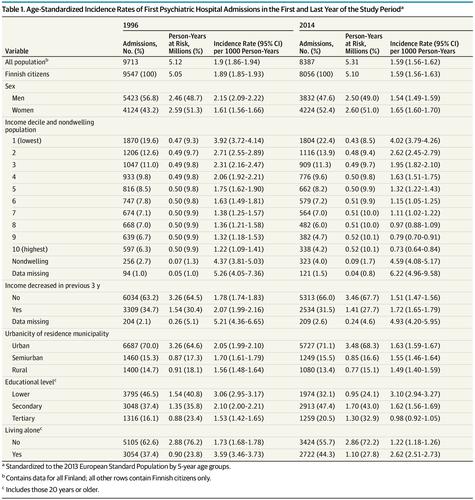当前位置:
X-MOL 学术
›
JAMA Psychiatry
›
论文详情
Our official English website, www.x-mol.net, welcomes your feedback! (Note: you will need to create a separate account there.)
Association of Income With the Incidence Rates of First Psychiatric Hospital Admissions in Finland, 1996-2014.
JAMA Psychiatry ( IF 25.8 ) Pub Date : 2019-12-18 , DOI: 10.1001/jamapsychiatry.2019.3647 Kimmo Suokas 1 , Anna-Maija Koivisto 1 , Christian Hakulinen 2, 3 , Riittakerttu Kaltiala 4, 5 , Reijo Sund 6 , Sonja Lumme 3 , Olli Kampman 4, 7 , Sami Pirkola 1, 7
JAMA Psychiatry ( IF 25.8 ) Pub Date : 2019-12-18 , DOI: 10.1001/jamapsychiatry.2019.3647 Kimmo Suokas 1 , Anna-Maija Koivisto 1 , Christian Hakulinen 2, 3 , Riittakerttu Kaltiala 4, 5 , Reijo Sund 6 , Sonja Lumme 3 , Olli Kampman 4, 7 , Sami Pirkola 1, 7
Affiliation

|
Importance
The association between income and mental health has long been a question of interest. Nationwide register data provide means to examine trends and patterns of these associations.
Objectives
To compare income-specific trends in the incidence rates of first psychiatric hospital admissions and to evaluate whether an income gradient exists in the incidence rates at all levels of household income.
Design, Setting, and Participants
This population-based open cohort study used linked registry data from nationwide Finnish Hospital Discharge and Statistics Finland population registers to determine annual incidence rates of first psychiatric hospital admissions. All Finnish citizens (N = 6 258 033) living in the country at any time from January 1, 1996, through December 31, 2014, contributed to 96 184 614 person-years at risk of first inpatient treatment for mental disorders. The analyses were conducted from August 1, 2018, through September 30, 2019.
Exposures
Equivalized disposable income, sex, age group, reduction in income decile in the previous 3 years, urbanicity, educational level, and living alone status.
Main Outcomes and Measures
Annual percentage changes in the age-standardized incidence rates and incidence rate ratios (IRRs).
Results
Altogether, 186 082 first psychiatric inpatient treatment episodes occurred (93 431 [50.2%] men), with overall age-standardized incidence rates per 1000 person-years varying from 1.59 (95% CI, 1.56-1.63) in 2014 to 2.11 (95% CI, 2.07-2.15) in 2008. In the highest income deciles, a continuous mean decrease per year of 3.71% (95% CI, 2.82%-4.59%) in men and 0.91% (95% CI, 0.01%-1.80%) in women occurred throughout the study period, in contrast to the lowest deciles, where the trends first increased (1.31% [95% CI, 0.62%-2.01%] increase in men from 1996 to 2007 and 5.61% [95% CI, 2.36%-8.96%] increase in women from 1996 to 2001). In the adult population, an income gradient was observed at all levels of household income: the lower the income decile, the higher the adjusted IRRs compared with the highest decile. The IRRs in the lowest decile varied from 2.94 (95% CI, 2.78-3.11) to 4.46 (95% CI, 4.17-4.76). In other age groups, the gradient did not persist at the highest income deciles. Diagnosis-specific income gradient was steepest in schizophrenia and related psychotic disorders, with estimated IRRs of the lowest income decile of 5.89 (95% CI, 5.77-6.02).
Conclusions and Relevance
In this cohort study, clear negative income gradient in the incidence rates of first hospital-treated mental disorders was observed in the adult population of Finland. These findings suggest that reduction in the use of inpatient care has not taken place equally between different income groups.
中文翻译:

1996-2014 年芬兰第一家精神病院入院率与收入的关联。
重要性 收入与心理健康之间的关联一直是人们感兴趣的问题。全国登记数据提供了检查这些关联的趋势和模式的方法。目的 比较首次精神病院住院发病率的收入特定趋势,并评估所有家庭收入水平的发病率是否存在收入梯度。设计、设置和参与者 这项基于人群的开放队列研究使用来自芬兰全国医院出院和芬兰人口登记处的关联登记数据来确定首次精神病院入院的年发病率。1996 年 1 月 1 日至 2014 年 12 月 31 日期间居住在该国的所有芬兰公民 (N = 6 258 033),导致 96 184 614 人年面临首次住院治疗精神障碍的风险。分析于 2018 年 8 月 1 日至 2019 年 9 月 30 日期间进行。暴露可支配收入、性别、年龄组、前 3 年收入减少的十分位数、城市化程度、教育水平和独居状态。主要成果和措施 年龄标准化发病率和发病率比 (IRR) 的年度百分比变化。结果 总共发生了 186 082 例首次精神科住院治疗(93 431 [50.2%] 男性),每 1000 人年的总体年龄标准化发病率从 2014 年的 1.59(95% CI,1.56-1.63)变化到 2.11( 95% CI, 2.07-2.15) 在 2008 年。在最高收入的十分位数中,男性和 0.91% (95% CI, 0.01%-) 每年连续平均下降 3.71% (95% CI, 2.82%-4.59%) 1. 80%) 在整个研究期间发生在女性中,与最低十分位数相反,其中趋势首先增加(1996 年至 2007 年男性增加 1.31% [95% CI,0.62%-2.01%] 和 5.61% [95% CI,2.36%-8.96%] 从 1996 年到 2001 年女性增加)。在成年人口中,所有家庭收入水平都存在收入梯度:收入十分位越低,与最高十分位相比,调整后的内部收益率越高。最低十分位数的内部收益率从 2.94(95% CI,2.78-3.11)到 4.46(95% CI,4.17-4.76)不等。在其他年龄组中,梯度并没有持续到最高收入的十分位数。诊断特异性收入梯度在精神分裂症和相关精神障碍中最为陡峭,估计最低收入十分位数的 IRR 为 5.89(95% CI,5.77-6.02)。结论和相关性 在这项队列研究中,在芬兰的成年人群中观察到首次住院治疗的精神障碍的发病率出现明显的负收入梯度。这些研究结果表明,不同收入群体之间住院护理使用的减少并没有平等地发生。
更新日期:2020-03-05
中文翻译:

1996-2014 年芬兰第一家精神病院入院率与收入的关联。
重要性 收入与心理健康之间的关联一直是人们感兴趣的问题。全国登记数据提供了检查这些关联的趋势和模式的方法。目的 比较首次精神病院住院发病率的收入特定趋势,并评估所有家庭收入水平的发病率是否存在收入梯度。设计、设置和参与者 这项基于人群的开放队列研究使用来自芬兰全国医院出院和芬兰人口登记处的关联登记数据来确定首次精神病院入院的年发病率。1996 年 1 月 1 日至 2014 年 12 月 31 日期间居住在该国的所有芬兰公民 (N = 6 258 033),导致 96 184 614 人年面临首次住院治疗精神障碍的风险。分析于 2018 年 8 月 1 日至 2019 年 9 月 30 日期间进行。暴露可支配收入、性别、年龄组、前 3 年收入减少的十分位数、城市化程度、教育水平和独居状态。主要成果和措施 年龄标准化发病率和发病率比 (IRR) 的年度百分比变化。结果 总共发生了 186 082 例首次精神科住院治疗(93 431 [50.2%] 男性),每 1000 人年的总体年龄标准化发病率从 2014 年的 1.59(95% CI,1.56-1.63)变化到 2.11( 95% CI, 2.07-2.15) 在 2008 年。在最高收入的十分位数中,男性和 0.91% (95% CI, 0.01%-) 每年连续平均下降 3.71% (95% CI, 2.82%-4.59%) 1. 80%) 在整个研究期间发生在女性中,与最低十分位数相反,其中趋势首先增加(1996 年至 2007 年男性增加 1.31% [95% CI,0.62%-2.01%] 和 5.61% [95% CI,2.36%-8.96%] 从 1996 年到 2001 年女性增加)。在成年人口中,所有家庭收入水平都存在收入梯度:收入十分位越低,与最高十分位相比,调整后的内部收益率越高。最低十分位数的内部收益率从 2.94(95% CI,2.78-3.11)到 4.46(95% CI,4.17-4.76)不等。在其他年龄组中,梯度并没有持续到最高收入的十分位数。诊断特异性收入梯度在精神分裂症和相关精神障碍中最为陡峭,估计最低收入十分位数的 IRR 为 5.89(95% CI,5.77-6.02)。结论和相关性 在这项队列研究中,在芬兰的成年人群中观察到首次住院治疗的精神障碍的发病率出现明显的负收入梯度。这些研究结果表明,不同收入群体之间住院护理使用的减少并没有平等地发生。



























 京公网安备 11010802027423号
京公网安备 11010802027423号